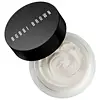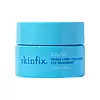What's inside
What's inside
 Key Ingredients
Key Ingredients

 Benefits
Benefits

 Concerns
Concerns

No concerns
 Ingredients Side-by-side
Ingredients Side-by-side

Water
Skin ConditioningPetrolatum
EmollientDimethicone
EmollientButyrospermum Parkii Butter
Skin ConditioningGlycerin
HumectantButylene Glycol
HumectantCeresin
Emulsion StabilisingPhenyl Trimethicone
Skin ConditioningLauryl PEG-9 Polydimethylsiloxyethyl Dimethicone
Skin ConditioningLanolin Alcohol
EmollientSorbitol
HumectantSodium Hyaluronate
HumectantScutellaria Baicalensis Root Extract
AstringentMorus Bombycis Root Extract
Skin ConditioningAscophyllum Nodosum Extract
Skin ConditioningAsparagopsis Armata Extract
Skin ProtectingCamellia Sinensis Leaf Extract
AntimicrobialOlea Europaea Fruit Extract
BleachingSalvia Sclarea Extract
AntiseborrhoeicPyrus Malus Fruit Extract
Skin ConditioningAcetyl Hexapeptide-8
HumectantLimnanthes Alba Seed Oil
Skin ConditioningOenothera Biennis Oil
EmollientTocopheryl Acetate
AntioxidantAcetyl Glucosamine
Skin ConditioningLinoleic Acid
CleansingCaffeine
Skin ConditioningMicrococcus Lysate
Skin ConditioningDi-C12-15 Alkyl Fumarate
EmollientVitis Vinifera Seed Oil
EmollientTriticum Vulgare Bran Extract
Skin ConditioningTrehalose
HumectantCholesterol
EmollientPinanediol
Skin ConditioningCamphanediol
Skin ConditioningSucrose
HumectantStearic Acid
CleansingPalmitic Acid
EmollientLecithin
EmollientPotassium Hydroxide
BufferingSilica
AbrasivePentylene Glycol
Skin ConditioningPEG-30 Dipolyhydroxystearate
EmulsifyingSodium Chloride
MaskingHydroxystearic Acid
CleansingPEG-8 Distearate
EmulsifyingBehenyl Alcohol
EmollientParfum
MaskingBenzyl Salicylate
PerfumingSodium Sulfite
PreservativeSodium Metabisulfite
AntioxidantDisodium EDTA
Tetrasodium EDTA
Chlorphenesin
AntimicrobialPotassium Sorbate
PreservativePhenoxyethanol
PreservativeWater, Petrolatum, Dimethicone, Butyrospermum Parkii Butter, Glycerin, Butylene Glycol, Ceresin, Phenyl Trimethicone, Lauryl PEG-9 Polydimethylsiloxyethyl Dimethicone, Lanolin Alcohol, Sorbitol, Sodium Hyaluronate, Scutellaria Baicalensis Root Extract, Morus Bombycis Root Extract, Ascophyllum Nodosum Extract, Asparagopsis Armata Extract, Camellia Sinensis Leaf Extract, Olea Europaea Fruit Extract, Salvia Sclarea Extract, Pyrus Malus Fruit Extract, Acetyl Hexapeptide-8, Limnanthes Alba Seed Oil, Oenothera Biennis Oil, Tocopheryl Acetate, Acetyl Glucosamine, Linoleic Acid, Caffeine, Micrococcus Lysate, Di-C12-15 Alkyl Fumarate, Vitis Vinifera Seed Oil, Triticum Vulgare Bran Extract, Trehalose, Cholesterol, Pinanediol, Camphanediol, Sucrose, Stearic Acid, Palmitic Acid, Lecithin, Potassium Hydroxide, Silica, Pentylene Glycol, PEG-30 Dipolyhydroxystearate, Sodium Chloride, Hydroxystearic Acid, PEG-8 Distearate, Behenyl Alcohol, Parfum, Benzyl Salicylate, Sodium Sulfite, Sodium Metabisulfite, Disodium EDTA, Tetrasodium EDTA, Chlorphenesin, Potassium Sorbate, Phenoxyethanol
Water
Skin ConditioningCaprylyl Caprylate/Caprate
EmollientJojoba Oil/Macadamia Seed Oil Esters
Skin ConditioningPropanediol
SolventNiacinamide
SmoothingAmmonium Acryloyldimethyltaurate/Vp Copolymer
Hydroxyethyl Acrylate/Sodium Acryloyldimethyl Taurate Copolymer
Emulsion StabilisingCollagen Amino Acids
MoisturisingSqualane
EmollientCaffeine
Skin ConditioningSqualene
EmollientMacadamia Integrifolia Seed Oil
Skin ConditioningAsparagopsis Armata Extract
Skin ProtectingHydrogenated Starch Hydrolysate
HumectantPhytosteryl Macadamiate
Skin ConditioningAcetyl Glucosamine
Skin ConditioningAcetyl Glutamine
Skin ConditioningLecithin
EmollientPhospholipids
Skin ConditioningLeuconostoc/Radish Root Ferment Filtrate
AntimicrobialPolyglutamic Acid
Skin ConditioningPhytosterols
Skin ConditioningAscophyllum Nodosum Extract
Skin ConditioningCeramide NP
Skin ConditioningBacillus/Soybean Ferment Extract
Skin ConditioningOligopeptide-3
Skin ConditioningOligopeptide-2
Skin ConditioningOligopeptide-1
Skin ConditioningHexapeptide-11
Skin ConditioningTocopheryl Acetate
AntioxidantSodium Hyaluronate
HumectantFolic Acid
Skin ConditioningAmylopectin
Tocopherol
AntioxidantPhytosphingosine
Skin ConditioningCeramide AP
Skin ConditioningCholesterol
EmollientLithothamnion Calcareum Extract
Skin ConditioningLactic Acid
BufferingMyrica Cerifera Fruit Extract
HumectantHydroxyacetophenone
AntioxidantPrunus Lannesiana Flower Extract
Skin ConditioningAkebia Quinata Stem Extract
Skin ConditioningSaccharomyces Lysate
Skin ConditioningLactobacillus Ferment Lysate
Skin ConditioningCeramide EOP
Skin ConditioningTripeptide-1
Skin ConditioningCaprylyl Glycol
EmollientPolysorbate 60
EmulsifyingGlycerin
HumectantEthylhexylglycerin
Skin ConditioningHexylene Glycol
EmulsifyingSodium Lauroyl Lactylate
EmulsifyingSorbitan Isostearate
EmulsifyingTrisodium Ethylenediamine Disuccinate
Butylene Glycol
HumectantPentylene Glycol
Skin ConditioningXanthan Gum
EmulsifyingCarbomer
Emulsion StabilisingSodium Benzoate
MaskingPotassium Sorbate
Preservative1,2-Hexanediol
Skin ConditioningDextran
Phenoxyethanol
PreservativeWater, Caprylyl Caprylate/Caprate, Jojoba Oil/Macadamia Seed Oil Esters, Propanediol, Niacinamide, Ammonium Acryloyldimethyltaurate/Vp Copolymer, Hydroxyethyl Acrylate/Sodium Acryloyldimethyl Taurate Copolymer, Collagen Amino Acids, Squalane, Caffeine, Squalene, Macadamia Integrifolia Seed Oil, Asparagopsis Armata Extract, Hydrogenated Starch Hydrolysate, Phytosteryl Macadamiate, Acetyl Glucosamine, Acetyl Glutamine, Lecithin, Phospholipids, Leuconostoc/Radish Root Ferment Filtrate, Polyglutamic Acid, Phytosterols, Ascophyllum Nodosum Extract, Ceramide NP, Bacillus/Soybean Ferment Extract, Oligopeptide-3, Oligopeptide-2, Oligopeptide-1, Hexapeptide-11, Tocopheryl Acetate, Sodium Hyaluronate, Folic Acid, Amylopectin, Tocopherol, Phytosphingosine, Ceramide AP, Cholesterol, Lithothamnion Calcareum Extract, Lactic Acid, Myrica Cerifera Fruit Extract, Hydroxyacetophenone, Prunus Lannesiana Flower Extract, Akebia Quinata Stem Extract, Saccharomyces Lysate, Lactobacillus Ferment Lysate, Ceramide EOP, Tripeptide-1, Caprylyl Glycol, Polysorbate 60, Glycerin, Ethylhexylglycerin, Hexylene Glycol, Sodium Lauroyl Lactylate, Sorbitan Isostearate, Trisodium Ethylenediamine Disuccinate, Butylene Glycol, Pentylene Glycol, Xanthan Gum, Carbomer, Sodium Benzoate, Potassium Sorbate, 1,2-Hexanediol, Dextran, Phenoxyethanol
Ingredients Explained
These ingredients are found in both products.
Ingredients higher up in an ingredient list are typically present in a larger amount.
Acetyl Glucosamine is an antioxidant and humectant. It is an amino acid sugar and is naturally found in our skin.
The cool thing about this ingredient? It helps the skin produce hyaluronic acid and boost hydration. It also has antioxidant benefits to protect skin cells.
When paired with niacinamide, Acetyl Glucosamine has been shown to be effective at reducing discoloration.
Learn more about Acetyl GlucosamineAscophyllum Nodosum Extract is from brown seaweed that grows in the northern Atlantic Ocean. It is an antioxidant. Antioxidants help fight off free-radicals. Free-radicals are molecules that may damage our skin cells.
Ascophyllum Nodosum Extract is also used to enhance the texture of products.
Asparagopsis Armata Extract is from seaweed. It is an antioxidant. Antioxidants help fight off free-radical molecules. These molecules damage our cells.
Asparagopsis Armata Extract may also be used to enhance the texture of products.
Ongoing research shows Asparagopsis Armata Extract may have antimicrobial properties.
Learn more about Asparagopsis Armata ExtractButylene Glycol (or BG) is used within cosmetic products for a few different reasons:
Overall, Butylene Glycol is a safe and well-rounded ingredient that works well with other ingredients.
Though this ingredient works well with most skin types, some people with sensitive skin may experience a reaction such as allergic rashes, closed comedones, or itchiness.
Learn more about Butylene GlycolCaffeine is most associated with coffee, tea, and cacao. In skincare, it helps with calming inflammation and is rich in antioxidants.
While caffeine is used to treat cellulite and and dark circles, further studies are needed to prove this. It has been believed to help with these skin conditions due to its ability to dilate blood vessels and increase blood flow.
Some studies are looking into caffeine's ability to protect against UV rays.
Learn more about CaffeineCholesterol is a class of organic molecules called lipids. It helps hydrate your skin and is essential to having a healthy skin barrier.
Our skin naturally contains cholesterol in the outermost layer. Besides cholesterol, it also contains ceramides and fatty acids. Cholesterol makes up about 1/4 of your skin's outer layer and barrier. Your skin barrier is responsible for keeping allergens and microbes out. Having a healthy skin barrier is also responsible for keeping your skin firm and plump.
Our bodies use cholestrol to create vitamin D, steroid hormones, and more.
Learn more about CholesterolGlycerin is already naturally found in your skin. It helps moisturize and protect your skin.
A study from 2016 found glycerin to be more effective as a humectant than AHAs and hyaluronic acid.
As a humectant, it helps the skin stay hydrated by pulling moisture to your skin. The low molecular weight of glycerin allows it to pull moisture into the deeper layers of your skin.
Hydrated skin improves your skin barrier; Your skin barrier helps protect against irritants and bacteria.
Glycerin has also been found to have antimicrobial and antiviral properties. Due to these properties, glycerin is often used in wound and burn treatments.
In cosmetics, glycerin is usually derived from plants such as soybean or palm. However, it can also be sourced from animals, such as tallow or animal fat.
This ingredient is organic, colorless, odorless, and non-toxic.
Glycerin is the name for this ingredient in American English. British English uses Glycerol/Glycerine.
Learn more about GlycerinLecithin is a term for a group of substances found in the cell membranes of plants, animals, and humans. They are made up of mixture of phospholipids.
This ingredient has emollient and emulsifying properties.
As an emollient, lecithen helps soften the skin and creates a barrier to keep moisture in.
As an emulsifier, it also helps prevent water and oil ingredients from separating. Lecithin can also help ingredients be better absorbed by the skin.
This is because the phospholipids in lecithin produce liposomes. Liposomes help other ingredients get through the skin barrier.
Depending on the source of this ingredient, lecithin may not be fungal acne safe. This is because some sources of lecithin come from soybean oil, which may feed the malassezia yeast that feeds fungal acne.
We recommend reaching out to the brand you are purchasing from to inquire about the source of their lecithin.
Some other names for this ingredient include soy lecithin and deoiled soy lecithin.
Learn more about LecithinPentylene glycol is typically used within a product to thicken it. It also adds a smooth, soft, and moisturizing feel to the product. It is naturally found in plants such as sugar beets.
The hydrophilic trait of Pentylene Glycol makes it a humectant. As a humectant, Pentylene Glycol helps draw moisture from the air to your skin. This can help keep your skin hydrated.
This property also makes Pentylene Glycol a great texture enhancer. It can also help thicken or stabilize a product.
Pentylene Glycol also acts as a mild preservative and helps to keep a product microbe-free.
Some people may experience mild eye and skin irritation from Pentylene Glycol. We always recommend speaking with a professional about using this ingredient in your routine.
Pentylene Glycol has a low molecular weight and is part of the 1,2-glycol family.
Learn more about Pentylene GlycolPhenoxyethanol is a preservative that has germicide, antimicrobial, and aromatic properties. Studies show that phenoxyethanol can prevent microbial growth. By itself, it has a scent that is similar to that of a rose.
It's often used in formulations along with Caprylyl Glycol to preserve the shelf life of products.
Potassium Sorbate is a preservative used to prevent yeast and mold in products. It is commonly found in both cosmetic and food products.
This ingredient comes from potassium salt derived from sorbic acid. Sorbic acid is a natural antibiotic and effective against fungus.
Both potassium sorbate and sorbic acid can be found in baked goods, cheeses, dried meats, dried fruit, ice cream, pickles, wine, yogurt, and more.
You'll often find this ingredient used with other preservatives.
Learn more about Potassium SorbateSodium Hyaluronate is hyaluronic acid's salt form. It is commonly derived from the sodium salt of hyaluronic acid.
Like hyaluronic acid, it is great at holding water and acts as a humectant. This makes it a great skin hydrating ingredient.
Sodium Hyaluronate is naturally occurring in our bodies and is mostly found in eye fluid and joints.
These are some other common types of Hyaluronic Acid:
Learn more about Sodium HyaluronateTocopheryl Acetate is AKA Vitamin E. It is an antioxidant and protects your skin from free radicals. Free radicals damage the skin by breaking down collagen.
One study found using Tocopheryl Acetate with Vitamin C decreased the number of sunburned cells.
Tocopheryl Acetate is commonly found in both skincare and dietary supplements.
Learn more about Tocopheryl AcetateWater. It's the most common cosmetic ingredient of all. You'll usually see it at the top of ingredient lists, meaning that it makes up the largest part of the product.
So why is it so popular? Water most often acts as a solvent - this means that it helps dissolve other ingredients into the formulation.
You'll also recognize water as that liquid we all need to stay alive. If you see this, drink a glass of water. Stay hydrated!
Learn more about Water